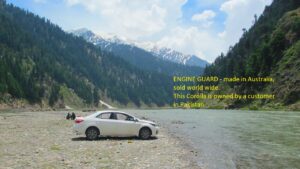I just want to start by saying that if you are sitting on the couch reading this and grinning cos it’s never gunna’ happen to you…………read on.
Sadly, most customers who cook an engine, then buy an Engine Guard, thought it would never happen to them as well. It does happen. It happens more than the manufacturers will ever admit. It happens in new or near-new vehicles, and it can be very bloody expensive. With older vehicles, it’s not a matter of if, it’s a matter of when.
Before we start to look at what causes overheating, here are a few issues that often come up when we talk to owners:
Are you covered under the new vehicle warranty for damage due to overheating?
This varies depending on the manufacturer but generally, new vehicle warranties cover components that might lead to overheating, but they don’t specifically cover the condition of overheating itself. What this means in the real world is almost entirely up to the discretion of the manufacturer and/or Dealer. If you own ‘certain’ brands, you better get a lawyer, son.
I’ll tell you a story that sheds a bit of light on this: a bloke rang me and wanted an Engine Guard for his newish Hilux ute. It was under warranty, but the car had just suffered its second overheating episode. The first time, the Dealer fixed it free-of-charge. The second time, the Dealer said it was improper use (it was a commercial parcel delivery vehicle) and refused to repair it under warranty. The car had lost coolant but there was no evidence of the cause so it was assumed that the driver had simply overloaded the engine and things went pear shaped. The diagnostics were inconclusive and this made it hard to work out what really went wrong. It also made it hard for the owner to prove that it was a manufacturing or component failure. It was a line ball decision, but from the Dealers perspective, it looked bad. Second time it happened. It’s rare for a Hilux to fail, commercial use, etc, etc. So they had Mexican stand-off over who paid the bill for the repairs.
Check out: Engine Guard EG01-2 Dual Temperature Sensor Kit
Then the apprentice working at the Dealer got told to clean up the drain pan they had used to catch the remaining coolant when the mechanics pulled the head off to check out the damage. He noticed there was sand in the bottom of the pan. Turns out there was a casting flaw in the block. Some of the sand mixture used when they poor the metal in the mould was left behind. Over time, it eroded and coolant flowed into more of the passages and this dropped the level of the coolant away from the cylinder head, etc. The problem should have been picked up during production or after the first repair, but it wasn’t.
So stuff happens. The owner bought the Engine Guard so he got warned early if it happens again.
Next time: Insurance and overheating?



